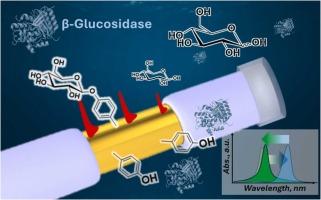利用功能等离子体有源光纤局部和表达探测酶活性
IF 3.7
1区 化学
Q1 CHEMISTRY, ANALYTICAL
引用次数: 0
摘要
酶是生物体的重要组成部分,也被人类积极地应用于各种技术过程中。酶的活性,特别是那些从微生物中分离出来的酶的活性,在不同的来源之间会有很大的不同。因此,有必要开发表达和最小侵入性检测酶活性的方法。在这项工作中,我们提出了一种酶活性生化传感器,该传感器基于等离子体活性光纤探针与酶敏感有机分子共价功能化,浸入溶液中,在各种实验条件下含有(或不含)β-葡萄糖苷酶。在酶的作用下,接枝到等离子体活性表面的有机基团发生C-O键的断裂,导致光纤探针的局部环境发生变化,并在背向反射光下监测到等离子体吸收带的光谱位置发生移位。在各种实验条件下,包括外部温度或pH值的变化,对所制备的光纤探针的功能进行了测试,得到的结果与传统的生化测试结果吻合良好。可以确定酶的存在,估计其浓度,并在不利的实验条件下抑制其活性。所提出的方法允许现场酶检测和廉价和快速的分析,对酶系统的破坏最小。本文章由计算机程序翻译,如有差异,请以英文原文为准。

Local and Express Probing of Enzymatic Activity Using Functional Plasmon Active Optical Fiber
Enzymes are very essential part of living organisms and are also actively used by humanity in various technological processes. The activity of enzymes, especially those isolated from microorganisms, can vary significantly from one to another source. Therefore, it is necessary to develop methods for express and the least invasive detection of enzymatic activity. In this work, we propose a biochemical sensor of enzymatic activity created on the basis of a plasmon-active optical fiber probe covalently functionalized with an enzyme-sensitive organic molecules, immersed in the solution, containing (or not) β-glucosidase at various experimental conditions. In the presence of enzyme, the grafted to plasmon-active surface organic moieties undergo cleavage of C-O bond leading to a change in the local environment of the optical fiber probe and to a shift in the spectral position plasmon absorption band, monitored in the back-reflected light. The functionality of the created optical fiber probe was tested at various experimental conditions, including the variation of the external temperature or pH, and results obtained correspond well with results of traditional biochemical tests. It is possible to determine the presence of the enzyme, estimate its concentration, and suppress its activity under unfavourable experimental conditions. The proposed approach allows in site enzyme detection and cheap and express analysis, with minimal disruption of enzymatic systems.
求助全文
通过发布文献求助,成功后即可免费获取论文全文。
去求助
来源期刊

Sensors and Actuators B: Chemical
工程技术-电化学
CiteScore
14.60
自引率
11.90%
发文量
1776
审稿时长
3.2 months
期刊介绍:
Sensors & Actuators, B: Chemical is an international journal focused on the research and development of chemical transducers. It covers chemical sensors and biosensors, chemical actuators, and analytical microsystems. The journal is interdisciplinary, aiming to publish original works showcasing substantial advancements beyond the current state of the art in these fields, with practical applicability to solving meaningful analytical problems. Review articles are accepted by invitation from an Editor of the journal.
 求助内容:
求助内容: 应助结果提醒方式:
应助结果提醒方式:


